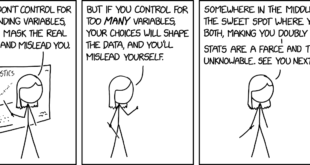.[embedded content] As always a pleasure listening to Edward Leamer and his critical views on the (mis)uses of statistical methods in empirical research. Main message: without a deep understanding of context, statistical and econometric analyses are useless!
Read More »Why we need causality in science
Why we need causality in science Many journal editors request authors to avoid causal language, and many observational researchers, trained in a scientific environment that frowns upon causality claims, spontaneously refrain from mentioning the C-word (“causal”) in their work … The proscription against the C-word is harmful to science because causal inference is a core task of science, regardless of whether the study is randomized or nonrandomized. Without...
Read More »Improving econometric analysis
Always, but always, plot your data. Remember that data quality is at least as important as data quantity. Always ask yourself, “Do these results make economic/common sense”? Check whether your “statistically significant” results are also “numerically/economically significant”. Be sure that you know exactly what assumptions are used/needed to obtain the results relating to the properties of any estimator or test that you use. Just because someone else has used a particular...
Read More »Guido Imbens on the response to LATE
.[embedded content] Many economists — yours truly included — are highly sceptical of the ability of mainstream economics to deliver useful models. Some of us even question the ‘modern’ insistence on modelling — “if it’s not in a model, it’s not economics.” Even if we accept the limitation of only being able to say something about (some kind of) average treatment effects when using instrumental-variables designs, a significant and major problem is that researchers who use these...
Read More »Manipulability — Pearl vs Rubin (wonkish)
Manipulability — Pearl vs Rubin (wonkish) Pearl asserts, while some RCM (Rubin Causal Models) theorists deny, that so-called “non-manipulable” variables can be causes (Pearl 2019; Holland 1986, 2008). Race and gender, which arguably cannot be experimentally manipulated, are key examples of such variables … My response is that although advocates of the frameworks adopt conflicting positions regarding certain variables, these positions are not forced upon...
Read More »Ignorability — a questionable assumption
Ignorability — a questionable assumption Researchers adhering to missing data analysis invariably invoke an ad-hoc assumption called “conditional ignorability,” often decorated as “ignorable treatment assignment mechanism”, which is far from being “well understood” by those who make it, let alone those who need to judge its plausibility. For readers versed in graphical modeling, “conditional ignorability” is none other than the back-door criterion that...
Read More »The dangers of too much control
The dangers of too much control You see it all the time in studies. “We controlled for…” And then the list starts … The more things you can control for, the stronger your study is — or, at least, the stronger your study seems. Controls give the feeling of specificity, of precision. But sometimes, you can control for too much. Sometimes you end up controlling for the thing you’re trying to measure … An example is research around the gender wage gap, which...
Read More »Causal traps of statistics
Causal traps of statistics .[embedded content] Statistical reasoning certainly seems paradoxical to most people. Take for example Simpson’s paradox. From a theoretical perspective, it importantly shows that causality can never be reduced to a question of statistics or probabilities unless you are — miraculously — able to keep constant all other factors that influence the probability of the outcome studied. To understand causality we always have to relate it...
Read More »The fundamental econometric dilemma
The fundamental econometric dilemma There is one point, to which in practice I attach a great importance, you do not allude to. In many of these statistical researches, in order to get enough observations they have to be scattered over a lengthy period of time; and for a lengthy period of time it very seldom remains true that the environment is sufficiently stable. That is the dilemma of many of these enquiries, which they do not seem to me to face....
Read More »The LATE approach — a critique
The LATE approach — a critique One of the reasons Guido Imbens and Joshua Angrist won the 2021 ‘Nobel prize’ in economics is their LATE approach used especially in instrumental variables estimation of causal effects. Another prominent ‘Nobel prize’ winner in economics — Angus Deaton — is not overly impressed: Without explicit prior consideration of the effect of the instrument choice on the parameter being estimated, such a procedure is effectively the...
Read More » Heterodox
Heterodox




